| CONSTANCE MEYER Articles |
|
It's always the heavy
Whether its tones are signaling dread or enforcing the ensemble's pitch, the bass makes an unmistakable mark. Just don't try to fly with one. March 5, 2006 | by Constance Meyer | The Los Angeles Times
Yes, violists may be the orchestra musicians who are traditionally the butt of jokes, but Los Angeles Philharmonic principal bassist Dennis Trembly is "surprised that viola jokes didn't land on bass players." That brand of humor, he believes, originates with players of "smaller instruments with more virtuosic possibilities. You can play more notes per second on a smaller instrument. We play fewer notes, so they may feel we're not working as hard."Trembly's fellow Philharmonic bass player David Moore (left) observes: "The sound of one bass or even a bass section is probably the most obscure instrumental sound in the entire orchestra. There are very few instances that you can even point to in the
repertoire. It's a challenge to prepare students for auditions because it's not like saying to a violinist working on the Brahms concerto, 'Pick up a dozen recordings. Go to iTunes so you can hear some examples of great solo violin playing.' " sound of one bass or even a bass section is probably the most obscure instrumental sound in the entire orchestra. There are very few instances that you can even point to in the
repertoire. It's a challenge to prepare students for auditions because it's not like saying to a violinist working on the Brahms concerto, 'Pick up a dozen recordings. Go to iTunes so you can hear some examples of great solo violin playing.' "
Yet whether it's referred to as a double bass, a contrabass, a string bass, an upright bass, an acoustic bass, a bass viol, a bass fiddle or even a bass violin, this mighty stringed instrument is indispensable to a full orchestra, which typically has a minimum of eight. The way Sue Ranney, principal bassist of the Los Angeles Chamber Orchestra, sees it, the bass is "the foundation of the orchestra. Pitch really starts from the bottom up. It's a problem when everybody just plays his or her own pitch -- you need to fall down to that bottom. We're the basis of the pitch, we're the basis of the rhythm. Bach continuo parts are the heart and soul of moving music forward. To me, Bach is what the bass is all about."
Moreover, the instrument's various incarnations have had three, four and five strings. Los Angeles Opera principal bassist David Young (right) explains: "Throughout the 19th century, there were many tunings and they were regional, so you play music and you try to interpolate what the composer really wanted."
An average bass stands from 6 to 6 1/2 feet tall, is 26 inches across at its widest part and is 8 inches deep. It can easily weigh 25 to 35 pounds. And because of its massiveness, people tend to think of it as "a man's instrument." Thirty years ago,
Ranney remembers, a musicians' contractor explained to her why she couldn't possibly be a principal player:
Consider Lisa Gass, a rail-thin freelance bassist and member of the Pasadena Symphony who studied instrument making at the Violin Making School of America in Salt Lake City. Gass* knows the bass inside out. She worked as the bass repair person in a violin shop in Los Angeles for 13 years and in 1997 opened her own business, LA Bassworks. The second floor has one room devoted to "all the really broken ones.""In the past," says Gass, "the sheer size of the bass dictated that students had to begin when they were older and bigger. Young children were channeled into violin because there were small instruments." However, because the Suzuki method of teaching youngsters to play musical instruments now includes the bass, "small basses are more available and desirable, even for little girls. Basses go all the way down to one-tenth size." All the same, Moore points out, "there are still more men than women in many bass sections, unlike the other strings, which are 50-50 or maybe even more than 50%. It may very well be the last bastion of male dominance in the strings in the orchestra."
A skill with some baggage TRANSPORTATION is a big deal to bass players. And the problems begin from the get-go, when as Ranney puts it, "the carpool mom doesn't want to take you because the bass might hurt the car upholstery." In fact, to get a bass from anyplace to anyplace else, a player has to wrestle with the sheer clumsiness of the instrument. Ranney continues: "They're not ridiculously heavy, but they're awkward because the weight is out front. You have to lift it to put it into the car, muscle it around, lift it to take it out." She remembers a day early in her career when "I was walking to the Libbey Bowl at Ojai, carrying my bass, a stool, a music stand and my clothes. A guy walking toward me asked: 'Got a match?' " Life improved enormously, about 10 or 15 years ago, she says, when a wheel was invented that enables players to roll their instruments rather than carry them.
But if flying has changed for everyone since 2001, it's become next to impossible for bass players. Trembly laments: "When you want to ship an instrument to be repaired in another state or to import one to try out to consider buying it, you have to deal with Homeland Security to let you ship it without you being on the plane with it. I once lent one of my basses to a Canadian group playing at LACMA because the U.S. wouldn't let them fly the bass in. The airlines can be very arbitrary. Some airlines won't accept them as extra baggage at all."Moore is specific about what's at stake. "Most of the safety of the instrument is in the quality of the case and knowing how to pack it properly," he says. "But you'll get to the airport and the security people will want to open, unpack and repack the case, and you, the bass player, are not supposed to touch it." He says that more than once, he's felt like telling transportation security employees, "Let's go into another room. I'm happy to strip naked and do this for you, but if it doesn't get put in right, I could get there and the thing could be irreparably damaged." He shakes his head in bafflement: "If you were to take any person off the street and say, 'I have a case that has a wide end and a narrow end and a flat side and an angled side. You're going to send it down a ramp -- how do you put it on?,' everyone would say, 'Flat side down, big side first.' " But despite his drawing "arrows and signs indicating which side is up and writing 'Fragile' all over, I can't tell you how many times you see it coming down neck first, lying on the bridge."
Gass remarks that sometimes "people with hand problems who play French come in to get a German bow, or vice versa. You can't just switch -- you have to work at it. Personally, I can't keep a German bow on the strings." Conversely, Trembly confesses that when he briefly tried a French bow, "I had grooves in my thumb, was black and blue on the side of my index finger from pressing, pinching, bad friction, and had no power in my stroke. I even dropped the bow a couple of times." Is it possible to hear the difference? According to Trembly, "One has suspicions." Shying from the spotlight AS that joke about the bass player attending "Carmen" indicates, basses rarely get the melody. Or as Trembly puts it: "In the orchestra, you've got Britten's 'Young Person's Guide,' Prokofiev's 'Lieutenant Kije,' Stravinsky's 'Pulcinella,' the Elephant in Saint-Saens' 'Carnival of the Animals' and various symphonic repertoire here and there. But for the most part, we don't play alone a lot, and when we suddenly do, it's kind of unnerving. It's an unaccustomed prominence which can make one insecure."
Young of L.A. Opera, who is also on the faculty of the Colburn School of Performing Arts, has a special fondness for the bass parts in Verdi. "In Othello's entrance into Desdemona's bedchamber," he says, "the basses play this moaning 'thing,' which step by step builds up to his determination to kill her. In the very beginning of 'Rigoletto,' there is dialogue going on above a melody played in octaves with one cello and one bass. With that extra deep darkness in it, there is the foreboding. You know that Rigoletto's daughter, whom he's protected from the Count, is going to get it, it's going to turn out the worst it could, and it does. That's the whole opera's tension. It's set up right there with the bass."
In the 20th century, Serge Koussevitzky, originally a bass player but better known as conductor of the Boston Symphony, also wrote for the bass. In the 1960s, native Californian Gary Karr (right) emerged as a superstar among bass players; Young goes so far as to say that Karr "should be considered the driving pioneering force who almost single-handedly elevated the bass to a solo instrument from a rare oddity." And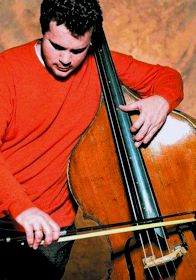 today there's
Edgar Meyer
(left), composer and bass player, the Yo-Yo Ma of the bass.
Ask any bassist and she or he will almost immediately run out of superlatives to characterize
Meyer, who will premiere his Double Bass Concerto No. 2 with the Los Angeles Chamber Orchestra on April 8 and 9. today there's
Edgar Meyer
(left), composer and bass player, the Yo-Yo Ma of the bass.
Ask any bassist and she or he will almost immediately run out of superlatives to characterize
Meyer, who will premiere his Double Bass Concerto No. 2 with the Los Angeles Chamber Orchestra on April 8 and 9.
In the end, the bass remains a quirky, unstandardized instrument whose players must act unceasingly as its advocates. Ranney puts her bass "out there" in her trio, L'eau, with a bassoonist and a violist. They play transcriptions as well as music they've commissioned. Bass players have sometimes been characterized as party animals, which may be stretching things. But they certainly have a sense of humor, as the PR for L'eau makes clear. The group, it says, performs works from "the Dark Ages to the Current Recession."
|
|
|
Copyright 2006 Constance Meyer. All rights reserved
*Photo
of Lisa Gass by Bryan Chan / Los Angeles Times |
|
|
|
|
|
|
|
|
|
|

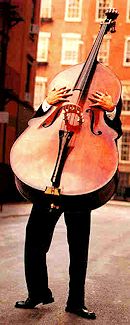 HEARD the one about the double bass player from the Metropolitan Opera who takes a night off to attend a performance of "Carmen"? Afterward, he rushes backstage to see his colleagues from the bass section.
"You know where we have those long plonk, plonk, plonk, plonks?" he exclaims. "You wouldn't believe what the violins are doing!" And he starts humming the Toreador Song.
HEARD the one about the double bass player from the Metropolitan Opera who takes a night off to attend a performance of "Carmen"? Afterward, he rushes backstage to see his colleagues from the bass section.
"You know where we have those long plonk, plonk, plonk, plonks?" he exclaims. "You wouldn't believe what the violins are doing!" And he starts humming the Toreador Song.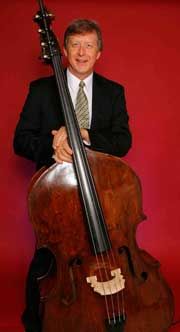 To many other people, the bass is the lowest-toned instrument in the violin family. Technically, though, it's an offspring of not only the violin but the viola da gamba, an early stringed instrument held between the knees and comparable in range to
the cello. Four hundred years after being perfected, the violin retains the same shape, it still has four strings, and it's still tuned in the musical intervals known as fifths. The basses in use today, though, reflect two traditions: the flat-backed,
rounded-body shape of the viola da gamba family and the curve-backed, more-pointed-corners shape of the violin. And to make matters even more confusing, basses with elements from each tradition abound.
To many other people, the bass is the lowest-toned instrument in the violin family. Technically, though, it's an offspring of not only the violin but the viola da gamba, an early stringed instrument held between the knees and comparable in range to
the cello. Four hundred years after being perfected, the violin retains the same shape, it still has four strings, and it's still tuned in the musical intervals known as fifths. The basses in use today, though, reflect two traditions: the flat-backed,
rounded-body shape of the viola da gamba family and the curve-backed, more-pointed-corners shape of the violin. And to make matters even more confusing, basses with elements from each tradition abound.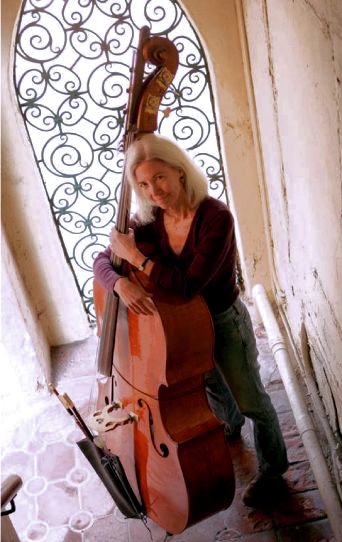 "Conductors want to see a strong guy back there." Says Moore: "I think the size of it gives people the mistaken impression that you have to be
a brute to play it. But it's a misconception, especially these days, with the advancements of the technical abilities of players and a more thorough understanding of body usage."
"Conductors want to see a strong guy back there." Says Moore: "I think the size of it gives people the mistaken impression that you have to be
a brute to play it. But it's a misconception, especially these days, with the advancements of the technical abilities of players and a more thorough understanding of body usage."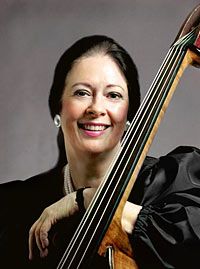 Ironically, it was a female bass player,
Ironically, it was a female bass player,  When traveling,
(Dennis)
When traveling,
(Dennis) 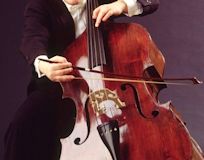 Another problem for bass players is that buying a string instrument and bow is not like buying a pair of shoes. They don't come in matching sets, and finding the right bow can often be the more difficult task. Plus, choosing a bass bow has an extra
twist. There are two types, French and
Another problem for bass players is that buying a string instrument and bow is not like buying a pair of shoes. They don't come in matching sets, and finding the right bow can often be the more difficult task. Plus, choosing a bass bow has an extra
twist. There are two types, French and 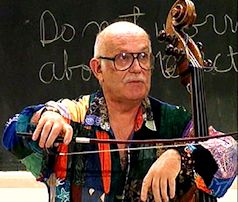 Ultimately, though, Trembly enjoys the spotlight. He is grateful to bass soloist
Ultimately, though, Trembly enjoys the spotlight. He is grateful to bass soloist
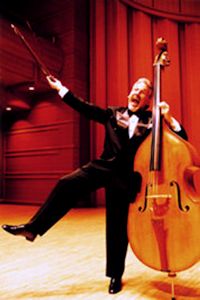 Moore, for his part, argues that many bass players "want to be part of a group, something larger than themselves. Few go into it because they want to be center stage." But there have been exceptions, and he notes that a number of them,
responding to the dearth of bass music, have written music for themselves. Domenico Dragonetti, a virtuoso bass player whose career spanned the latter half of the 18th and the first half of the 19th centuries, apparently inspired Beethoven.
Giovanni Bottesini was a hotshot in the 19th century who also composed pieces for himself.
Moore, for his part, argues that many bass players "want to be part of a group, something larger than themselves. Few go into it because they want to be center stage." But there have been exceptions, and he notes that a number of them,
responding to the dearth of bass music, have written music for themselves. Domenico Dragonetti, a virtuoso bass player whose career spanned the latter half of the 18th and the first half of the 19th centuries, apparently inspired Beethoven.
Giovanni Bottesini was a hotshot in the 19th century who also composed pieces for himself.